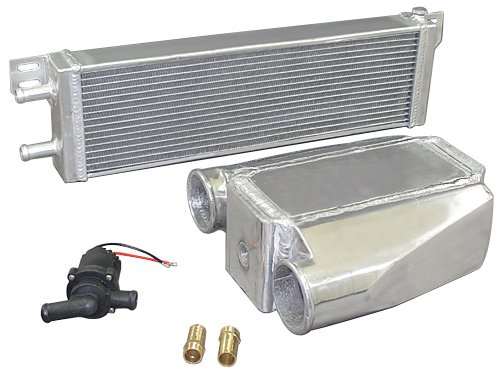Intercooler
Types of Intercoolers – All You Need to Know
Similar to radiators, intercoolers are heat exchangers that are commonly used in performance vehicles. Intercoolers cool down compressed air that is sent to the engine to avoid overheating and inefficiency. These devices are considered much more efficient than their counterparts as the forced induction systems are extremely effective.
Intercoolers are unique in the way they function, yet not all intercoolers are the same. There are two main categories with a few subtypes. However, to understand each type and its difference, it is essential to know how these devices function.
The function of an Intercooler
In simple terms, intercoolers cool down compressed air before it is circulated around the engine. But we have to move a few steps back to understand why this is needed. Vehicle engines require oxygen to burn fuel efficiently. With all the heat produced around the engine, it would mostly receive hot air. The problem with hot air is that it is less dense, meaning it contains fewer oxygen molecules. Less oxygen means less efficiency in burning fuel.
This is where intercoolers step in. These devices are designed to cool down compressed air. Since compressed air contains much more oxygen molecules, the engine will thrive and work effectively. Now the question is, how does an intercooler cool down this compressed air? That’s where the types come in. Each type of intercooler has a specific way of cooling down this compressed air. It could either be through the use of air or some type of fluid. We shall discuss both of these types in detail.
Types of Intercoolers
The two main categories of intercoolers are air-to-air and air-to-water intercoolers.
Air-to-Air Intercoolers

Generally, when people refer to intercoolers, the air-to-air intercoolers are the ones that come to mind. They are also a common sight as they are mounted on the front of most performance vehicles with a characteristic metallic body. These intercoolers consist of a metallic part that is covered by several overlapping tubes. They are also referred to as front-mount intercoolers, as they are attached to the front of vehicles. Front-mount intercoolers for BMW vehicles are a prime example for these types of intercoolers.
The heated air from the turbochargers enters the intercooler and flows through the external tubes. These tubes are exposed to the outside where atmospheric air cools down the heated air. The heat is released into the atmosphere while the cooled compressed air is pumped towards the intake manifold of the engine.
The reduction in the temperature of the air causes it to become dense with a higher concentration of oxygen. This air is now ready to be mixed with the fuel to generate a much higher power output. Cool air is also necessary for catalytic converters as they work more effectively when the temperature of the exhaust fumes is not too high. Moreover, releasing fumes at high temperatures is also illegal in many countries.
Air-to-air intercoolers further have two types. However, these types are not based on functioning, rather on their physical design.
Tube-and-Fin Intercoolers – As the name suggests, these intercoolers use a system of cooling fins and tubes to lower the temperature of the air. As the air passes through these tubes, the heat is transferred and cooler air is sent to the engine. These intercoolers are much cheaper and are more commonly used in non-performance vehicles. The only downside is that they can be overheated.
Bar-and-Plate Intercoolers – These intercoolers are much stronger compared to their counterpart. The heated air passes through a series of bars and plates that serve as a heat sink. These intercoolers provide much better performance without any downsides. However, they are much more expensive and bulkier.
Air-to-Water Intercoolers

Generally known as air-to-liquid air coolers, these intercoolers differ greatly from their counterparts mostly due to the use of liquid as a coolant. The functioning is similar to air-to-air intercoolers, with the only difference of a liquid being used to transfer heat from the air.
The functioning in these intercoolers remains the same. A liquid is pumped into the intercooler where heat is transferred from the heated air and into the coolant liquid. The cooled compressed air is sent back into the intake manifold of the engine while the liquid is cooled down through a separate radiator.
These intercoolers are much more efficient as liquids have a much higher temperature range compared to air. They are also much smaller and easier to fit, making them perfect for cars with less engine room.
Despite being much more complex, air-to-water intercoolers are extremely effective. Liquids are much better at transferring heat from the air, making them a top choice for performance vehicles. Air-to-air types can only be mounted to the front of the car; however, air-to-water intercoolers have much more options. They can be mounted to almost any place as long as the radiator receives proper airflow, such as the side-mount intercooler for Audi vehicles.
With all these immense benefits that air-to-water intercoolers offer, there are a few downsides as well. These intercoolers cost a lot more and they are much bulkier than their counterparts. This makes these intercoolers exclusive for performance and heavy-duty vehicles.
The Bottom Line
Both types of intercoolers serve the same function of cooling down the heated air and feeding it back to the engine. However, performance-wise, air-to-water intercoolers take the lead. If you’re wondering which intercooler is better for your car, it all boils down to your car’s type and its needs. If it’s a performance car, air-to-water intercoolers will be the best choice. However, for normal vehicles, air-to-air intercoolers work just fine. Get your own intercooler today from Turborevs and take your car’s performance to the next level.








